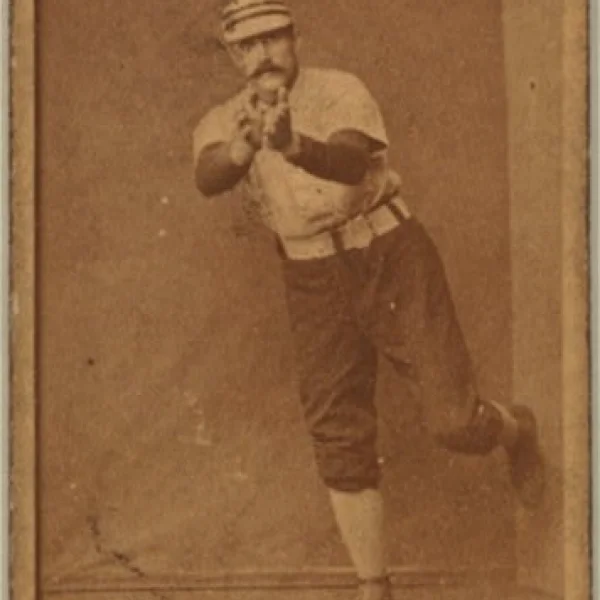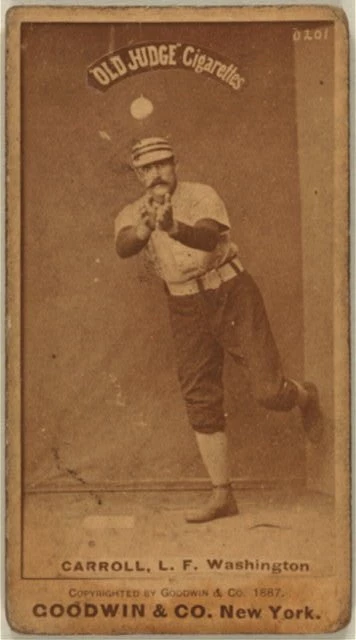With Major League Baseball’s spring training well underway in the warmer, sunnier climes of Florida and Arizona, thoughts of this writer naturally turn to Bloomington-Normal’s many and deep connections to the National Pastime.
When it comes to baseball, the Twin City’s favorite son has long been larger-than-life Charles “Old Hoss” Radbourn, the ill-tempered, right-handed pitcher who won an astounding 59 games for Providence, R.I. in 1884, which to this day remains the single-season big league record.
Yet even some local diehards of the game and its history don’t know that there was another Bloomingtonian on the Grays roster during Radbourn’s immortal season.
Indeed, Cliff Carroll, Providence’s standout leftfielder, learned to play game on the sandlots of Bloomington after the Civil War, this at a time when “base ball” (as it was often spelled back then) captured the nation’s imagination as it evolved into something recognizably close to the modern game.
This Bloomington-raised, right-handed, switch-hitting speedster enjoyed a productive eleven-year Major League career, becoming one of the best outfielders and base runners of the era. Yet Carroll walked away from big league fame and (relative) fortune to become a McLean County corn farmer. Yes, it’s true!
Born in Clay Grove, Ia., in 1859, Samuel Clifford Carroll spent the bulk of his formative years in the Twin Cities, only leaving Central Illinois in his late teens to play professional minor league ball.
Nineteenth century baseball and its rough-and-tumble, urban, working class milieu were characterized by toxic masculinity, profanity, hard-drinking, brawling, womanizing and gambling.
Carroll’s roots, on the other hand, were more middle class and genteel in nature. His parents, John and L. Marie Gustin Carroll, came to Bloomington in 1867 with son Cliff in tow, and for years the family ran a grocery store on the north end of downtown. Their well-kept home was on the 400 block of East Chestnut Street, just east of Franklin Park.
Cliff Carroll’s career as a paid athlete likely dates to 1877 when as a 17-year-old he played for one of Bloomington’s early semi-pro teams. The Bloomington “nine” (as clubs were often called) included Charlie Radbourn, Carroll’s future Providence teammate and National Baseball Hall of Fame inductee.
Astoundingly, when Carroll came into the National League as a Providence rookie in 1882, all but the catcher played the field barehanded. The slow transition to gloves wasn’t completed until the mid-1890s (and the glove’s distinctive web between the first finger and thumb wasn’t developed until the 1920s.)
Suffice to say, jammed, sprained and broken fingers were common, and amputations of shattered or infected digits were not unknown. Indeed, Carroll’s permanently misshapen fingers and swollen hands were shown in a 1911 newspaper with the caption, “Famous National Leaguer carries proof of long career on diamond.”
During the 1884 season, Carroll batted .261 (the league average was .247) as the leftfielder for the pennant-winning Grays. Of course, this season is best known today for Old Hoss Radbourn’s herculean feat of winning 59 games as a starting pitcher. It’s inconceivable that anyone will ever break—let alone come close to threatening—this 135-year-old record. After all, no one has reached even 30 victories in a single season since Denny McLain of the Detroit Tigers went 31-6 in 1968—and that was 51 years ago!
Let it be noted that Carroll made baseball history that season as well. It’s said that during an Aug. 9 home game against archrival Boston, he led off the bottom of eighth inning with what some writers contend was the first known (or at least first recorded) bunt in baseball history. According to one report, the 6,000 or so fans in attendance “roared with laughter” as Carroll tapped the ball before the befuddled Boston infielders and streaked safely to first base.
In the manly world of 19th century baseball, a bunt was almost an affront to spirit of the game. “A vigorous striking out,” lectured one reporter, “is preferable to a baby blow to the bat.” Nonetheless, all these many years later, the bunt remains an important part of the game.
After four years with the Providence Grays, Carroll played two seasons with the Washington, D.C. Nationals (they were also called the Senators or Statesmen). Then, in 1888, he appeared in 5 games for the Pittsburgh Alleghenys before hanging up his spikes and leaving the grit and glamour of professional baseball for the quieter and more solitary life as a Corn Belt farmer.
By all accounts, Carroll worked his Randolph Township farm in southern McLean County in apparent peace and anonymity. Yet in early 1890, he was called out of retirement by the legendary Adrian “Cap” Anson, skipper of the National League Chicago Colts (this was before the Colts became known as the Cubs!) “For two years Carroll has been farming south of the city, but has come to the conclusion that there is more money in base ball,” noted The Pantagraph.
“Farmer” Carroll (as he was sometimes nicknamed) appeared in 236 games over two seasons with the Colts, batting a career high .285 in his first year in the Windy City. In fact, he achieved personal bests in several offensive and defensive categories during the 1890 season.
He then finished his big league career with St. Louis (1892) and Boston (1893). During his eleventh and final season, Carroll was an everyday outfielder as the 86-43 Beaneaters captured the 12-team National League pennant.
The 34 year old Carroll then walked away from the game once more, though “this time for all time.” Again, he turned to farming, settling in east central Illinois, near the Vermilion County community of Hoopeston.
A move to Portland, Ore. followed sometime around 1910, and it was there that Samuel Clifford Carroll passed away on Jun. 12, 1923. His death was noted across the country. “Carroll,” remarked The Rock Island Argus newspaper, “was one of the favorite heroes of the olden days as [Babe] Ruth is at the present.”
“Carroll was the proud possessor of a great collection of trophies won on the ball field and innumerable souvenirs gathered during his 17 years on the diamond,” remembered Pittsburgh sportswriter Ed F. Ballinger (who must’ve included some minor league seasons when totaling up Carroll’s career.) “One of his favorite keepsakes which now is highly prized by his family, is a winged foot of solid gold inlaid with many diamonds. It was gift of admiring fans and it symbolized the fleetness for which he was famed in his time.”
Yet once out of the game, Carroll didn’t seem to miss the adulation. “One of the greatest baseball players of the game died in Portland recently,” observed The Oregonian, a Portland newspaper, “but so modest was he that few even knew he had been spending his last years here.”

